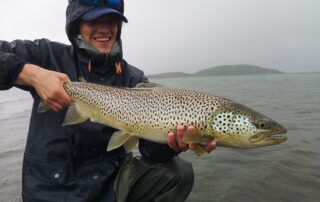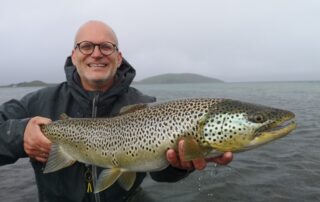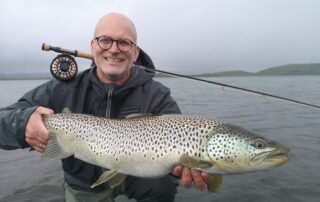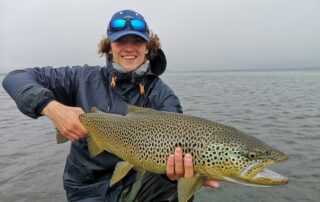Thingvellir National Park

Fishing trips to Lake Thingvellir
Fishing permits for the ION area – best brown trout area in Iceland
Lake Thingvellir
Location: The lake is situated approx. 50 km. from Reykjavík.
Season: Fishing is only allowed from April 20th – September 15th.
Bait: Only fly, worm and lure. Fly only from April 20 – June 1st.
Accommodation: Þingvellir is a popular summer resort, and has thus a number of options. Camping sites are located in various places around the lake. Permits can be purchased at the Service Centre.
Vatnskot is an exciting camping site, where one can also receive information concerning the best fishing grounds.
Thingvellir National Park
No single place epitomizes the history of Iceland and the Icelandic nation better than Þingvellir by the river Öxará.
At Þingvellir – literally “Parliament Plains” – the Alþing general assembly was established around 930 and continued to convene there until 1798. Major events in the history of Iceland have taken place at Þingvellir and therefore the place is held in high esteem by all Icelanders. Today Þingvellir is a protected national shrine. According to the law, passed in 1928, the protected area shall always be the property of the Icelandic nation, under the preservation of the Alþing.
Lake Thingvallavatn
Lake Thingvellir lies in a rift valley that extends south from the Langjökull glacier to mount Hengill, and from Botnssúlur in the west to Lyngdalsheiði in the east. Lake Þingvallavatn is the largest natural lake in Iceland, about 84 square kilometres, at an altitude of about 100 metres above sea level. The deepest part of the lake measures 114 metres, which means that it reaches below sea level.
The catchment area of Þingvallavatn, about 1300 square kilometres, lies in the same direction as the fissures in the area, and its existence is closely connected with the geological history. There is a great deal of precipitation in the catchment area. About 9/10 of the water influx in Þingvallavatn runs along underground channels to the lake. It takes 20-30 years for water to run south into Þingvallavatn from the glacier Langjökull, and it’s said that, on its way, it passes through the earth’s mantle at a depth of eight kilometres.
Relatively very few faunal species are found in Iceland. The main reason is, of course, the distance between Iceland and the mainland, but also the relatively short time since the end of the last Ice Age.
The fish in the lake
Lake Þingvallavatn is no exception, and in the lake there live three of the five species of freshwater fish found in Iceland: brown trout, Arctic charr and the three-spine stickleback. It’s said that these fish became isolated in the lake in the wake of the last ice age when the terrain rose at the south end of Þingvallavatn.
These three species are a living testimony to how the evolution of species occurs in nature, as over a period of 10,000 years they have adapted themselves to various habitats in the lake. The constant, regular influx of groundwater into Lake Þingvallavatn, together with a very varied habitat, has created good conditions for fish and other life forms in the lake, to which they have adapted even more.
Such evolution is reflected in the different types of Arctic charr and stickleback, along with varying populations of brown trout. Because of this, Þingvallavatn has recently become a focus of research activity on the first stages of variety and species formation.
THE BROWN TROUT
 The brown trout in Lake Þingvallavatn, whose origin can be traced to Britain, has long been one of the most talked-about freshwater fish in Iceland – and abroad. The brown trout’s fame is based primarily on its large size and great numbers. After it became isolated in Þingvallavatn in the wake of the last ice age, living conditions proved beneficial, and it was found in many populations all over the lake.
The brown trout in Lake Þingvallavatn, whose origin can be traced to Britain, has long been one of the most talked-about freshwater fish in Iceland – and abroad. The brown trout’s fame is based primarily on its large size and great numbers. After it became isolated in Þingvallavatn in the wake of the last ice age, living conditions proved beneficial, and it was found in many populations all over the lake.
 The best-known population was connected with Efra-Sog, which was the natural output of Þingvallavatn to the south, while another well-known population still has its spawning site in the river Öxará. The main reasons why the lake’s largest brown trout population stayed in Efra-Sog were the strong current and river gravel that created good conditions for spawning and for the development of black flies, a good food source.
The best-known population was connected with Efra-Sog, which was the natural output of Þingvallavatn to the south, while another well-known population still has its spawning site in the river Öxará. The main reasons why the lake’s largest brown trout population stayed in Efra-Sog were the strong current and river gravel that created good conditions for spawning and for the development of black flies, a good food source.
The brown trout can reach an incredible size, that once attracted anglers from all over the world. Records show that it wasn’t uncommon to catch a 20-30 pound brown trout. When the Steingrímsstöð hydroelectric plant was built in 1959 at the southern end of the lake, the largest spawning site of the brown trout was destroyed, and the largest brown trout population in the lake has yet to recover.
Recently, the life habits of the brown trout have been researched in detail in order to learn more about this lake giant. During this research, brown trout up to 20 pounds in weight have been observed in the river Öxará.
ARCTIC CHARR
 In one respect Lake Þingvallavatn is unique in the world, since it supports four separate varieties of the Arctic char. The Arctic charr in Lake Þingvallavatn are a good example of how species evolve and adapt to their surroundings, as these four varieties have evolved from one species in only 10,000 years.
In one respect Lake Þingvallavatn is unique in the world, since it supports four separate varieties of the Arctic char. The Arctic charr in Lake Þingvallavatn are a good example of how species evolve and adapt to their surroundings, as these four varieties have evolved from one species in only 10,000 years.
The Arctic charr, or bleikja, have adapted themselves to two main lake habitats, the main body of water and the bottom of the lake. In the main body of the lake, the food source of the Arctic charr is constantly on the move and the fish themselves have little shelter from predators. The Arctic charr that have evolved under these conditions are streamlined and have a long lower jaw.
The fish-eating type, the Sílableikja (piscivorous charr), can grow up to 40 centimetres in length, while the plant-eating Murta (planktivorous charr) is a lot smaller, usually only about 20 centimetres in length.The lake bottom is the main habitat of the large snail-eating charr and the dwarf-charr. There is enough food there and also plenty of places to hide from predators. The snail-eating charr can be up to 50 centimetres in length, while the dwarf-charr stands up to its name and is usually only 10-13 centimetres. The dwarf-arctic charr can often be seen in the Flosagjá fault (Money rift), where it darts among the coins that tourists throw in the rift.
THREE SPINE STICKLEBACKS
Sticklebacks have adapted themselves to their surroundingsin the same way as Arctic charr, as 2 varieties of stickleback have evolved. One variety stays in the vegetation belt at a depth of 25-30 metres, where a suitable habitat is found, while the other frequents shallower areas amongst the lava stones. Sticklebacks are by far the most common fish in the lake; their number estimated at 85 million.
An old Icelandic proverb says “Fertile is water that runs under lava.” The proverb is particularly appropriate for the water that flows into Lake Þingvallavatn. The close relationship between the ecosystem of Lake Þingvallavatn and geological history gives Þingvallavatn a special place amongst the
world’s lakes.
The Lake – Nature
 The majority of the catchment area is covered by lava and water easily drains through. The young age of the lava means that there is a high uptake of minerals in the groundwater, and this is one of the reasons for the great diversity of life in Þingvallavatn. Land subsidence, rifting and lava have created a diverse habitat, for instance hideouts for fish in fissures and holes along the shoreline.
The majority of the catchment area is covered by lava and water easily drains through. The young age of the lava means that there is a high uptake of minerals in the groundwater, and this is one of the reasons for the great diversity of life in Þingvallavatn. Land subsidence, rifting and lava have created a diverse habitat, for instance hideouts for fish in fissures and holes along the shoreline.
The lake is particularly fertile and rich in vegetation, despite the very cold temperatures. A third of the bottom area is covered by vegetation, and there is a large amount of algae. Low-growing vegetation extends out to a depth of 10 metres while higher vegetation forms a large growing-belt to 10-30 metres deep.
A total of 150 types of plants have been found and 50 kinds of invertebrates, from the shore to the center.
Contact info
E-mail: info@anglers.is
Tel: +354 897 3443










